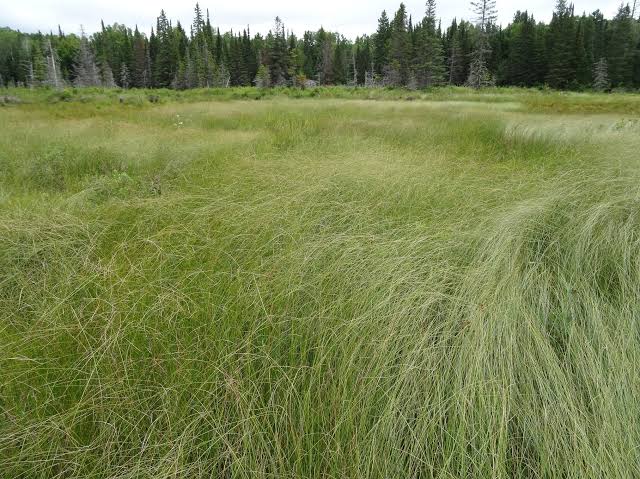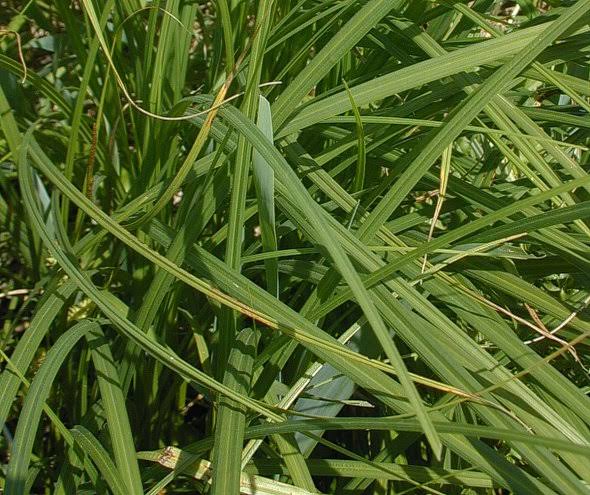Woolfruit sedge (Carex lasiocarpa) is a remarkable plant that thrives in wetlands and moist habitats. This unique species is known for its slender, green stems and distinctive seed heads, resembling woolly fruits. Its scientific name, Carex lasiocarpa, reflects its characteristic woolly appearance.
In terms of habitat, Woolfruit sedge is commonly found in marshes, bogs, and along the edges of lakes and streams. This versatile plant has adapted to a range of soil types, demonstrating its resilience in diverse environments. Its ability to thrive in wet conditions makes it a valuable component of ecosystems, contributing to the overall biodiversity of these areas.
One of the notable features of Woolfruit sedge is its grass-like leaves, which are often narrow and arching. These leaves play a crucial role in the plant’s photosynthesis process, capturing sunlight to produce energy. The unique structure of these leaves also provides shelter and habitat for various small organisms, contributing to the ecological balance of its surroundings.
During the flowering season, Woolfruit sedge produces inconspicuous flowers clustered into compact spikelets. These flowers give way to the distinctive woolly seed heads that resemble tiny fruits, hence the name “Woolfruit sedge.” The fluffy appearance of these seed heads adds aesthetic value to the plant and makes it easily recognizable in its natural habitat.
Beyond its visual appeal, Woolfruit sedge serves important ecological functions. Its extensive root system helps stabilize soil in wetland areas, preventing erosion and supporting the overall health of the ecosystem. Additionally, the plant provides habitat and food for various wildlife, including insects and birds that rely on it for shelter and sustenance.
Conservation efforts often recognize the significance of Woolfruit sedge in maintaining wetland ecosystems. Protecting and preserving these habitats not only ensures the survival of this unique plant species but also contributes to the well-being of numerous other organisms dependent on these environments.
In addition, Woolfruit sedge (Carex lasiocarpa) stands out as a resilient and ecologically valuable plant. Its adaptability to wetland conditions, distinctive appearance, and ecological contributions make it a noteworthy species in the intricate web of biodiversity. Understanding and appreciating the role of Woolfruit sedge in its natural habitat is essential for the conservation and sustainable management of wetland ecosystems.
Read Also: How to Farm and Care for Pacific Sand Lance Fish (Ammodytes personatus)
How To Grow Woolfruit Sedge (Carex lasiocarpa)

To successfully grow Woolfruit sedge (Carex lasiocarpa), follow these guidelines:
1. Select a Suitable Location: Choose a site with moist or wet soil conditions, replicating the natural habitat of Woolfruit sedge. Areas near lakes, streams, or wetlands are ideal.
2. Soil Preparation: Ensure the soil is well-draining and rich in organic matter. Woolfruit sedge prefers slightly acidic to neutral soil pH.
3. Sunlight Requirements: While Woolfruit sedge can tolerate partial shade, it generally thrives in full sun. Choose a location that receives adequate sunlight throughout the day.
4. Planting: Plant Woolfruit sedge in early spring or fall. Dig a hole slightly larger than the root ball, place the plant in the hole, and backfill with soil. Water thoroughly after planting.
5. Watering: Keep the soil consistently moist. Woolfruit sedge is well-suited to wet conditions, so regular watering is crucial, especially during dry periods.
6. Mulching: Apply a layer of organic mulch around the base of the plant to retain soil moisture and suppress weeds.
7. Fertilization: While Woolfruit sedge is not overly demanding, you can incorporate a balanced, slow-release fertilizer in the spring to support its growth.
8. Pruning: Trim back any dead or damaged leaves as needed. This helps maintain the plant’s appearance and encourages new growth.
9. Division: If the sedge becomes overcrowded or outgrows its space, consider dividing it in early spring. This promotes healthier growth and can be an effective means of propagation.
10. Pest and Disease Management: Woolfruit sedge is generally resistant to pests and diseases. However, regular monitoring for any signs of issues is advisable. Treat any problems promptly with appropriate measures.
11. Winter Care: In colder climates, Woolfruit sedge may die back in winter and resprout in spring. Applying a layer of mulch around the base can provide some protection during harsh winter conditions.
By following these straightforward steps, you can cultivate Woolfruit sedge and enjoy its unique characteristics in your garden or wetland landscape.
How To Care For Woolfruit Sedge (Carex lasiocarpa)
To care for Woolfruit sedge (Carex lasiocarpa):
1. Watering: Keep the soil consistently moist, ensuring it mimics the wet conditions of its natural habitat. Water regularly, especially during dry spells.
2. Sunlight: Provide ample sunlight, as Woolfruit sedge generally prefers full sun. While it can tolerate partial shade, optimal growth occurs with sufficient sunlight exposure.
3. Soil Conditions: Plant in well-draining soil with good organic content. Aim for a soil pH that is slightly acidic to neutral, replicating its native environment.
4. Mulching: Apply organic mulch around the base to retain moisture, suppress weeds, and enhance soil fertility. Mulching contributes to the overall health of the plant.
5. Fertilization: Use a balanced, slow-release fertilizer in the spring to support growth. While Woolfruit sedge is not highly demanding, this extra boost can be beneficial.
6. Pruning: Trim any dead or damaged leaves as necessary to maintain the plant’s appearance and stimulate new growth. Regular pruning can enhance its overall health.
7. Division: Consider dividing the sedge in early spring if it becomes overcrowded. This promotes better growth and can be a method of propagation.
8. Pest and Disease Management: Monitor for pests and diseases regularly, although Woolfruit sedge is generally resistant. Address any issues promptly with suitable measures if they arise.
9. Winter Care: In colder climates, the plant may die back in winter and resprout in spring. Applying a layer of mulch around the base provides some protection during harsh winter conditions.
By following these care guidelines, you can cultivate and maintain a healthy Woolfruit sedge in your garden or landscape.
Read Also: How to Farm and Care for Blue Swimming Crab (Portunus pelagicus)
The Uses of Woolfruit Sedge (Carex lasiocarpa)

Woolfruit sedge (Carex lasiocarpa) serves various ecological and practical purposes:
1. Erosion Control: The extensive root system of Woolfruit sedge helps stabilize soil in wetland areas, preventing erosion. Planting it along shorelines or in areas prone to soil loss contributes to effective erosion control.
2. Habitat for Wildlife: The grass-like leaves and dense growth of Woolfruit sedge provide habitat and shelter for various wildlife. Insects, small mammals, and birds find refuge in its foliage, contributing to local biodiversity.
3. Wetland Restoration: Due to its preference for wet conditions, Woolfruit sedge plays a crucial role in wetland ecosystems. Its presence contributes to the restoration and maintenance of these valuable and sensitive environments.
4. Aesthetic Value: The distinctive woolly seed heads of Woolfruit sedge add visual interest to landscapes. Gardens, wetland restoration projects, or naturalistic landscapes benefit from its unique appearance.
5. Water Filtration: Wetland plants, including Woolfruit sedge, play a part in water filtration. Their root systems can help absorb excess nutrients and filter pollutants, contributing to improved water quality.
6. Educational and Research Purposes: Scientists and educators often study plants like Woolfruit sedge to better understand wetland ecosystems, plant adaptations, and ecological interactions. Its presence in botanical gardens and educational landscapes can aid in these efforts.
7. Conservation and Restoration: Recognizing the ecological importance of Woolfruit sedge, conservation efforts may focus on preserving its natural habitats. Including it in restoration projects helps enhance the overall health of wetland ecosystems.
8. Cultural Uses: While not traditionally a significant resource for human use, some indigenous cultures may have historical or cultural connections to plants like Woolfruit sedge. Understanding and respecting these connections contribute to cultural and environmental conservation.
In addition, Woolfruit sedge serves a range of ecological functions, contributing to the health and balance of wetland ecosystems. Its aesthetic qualities and adaptability make it a valuable asset in landscaping and conservation efforts.
Frequently Asked Questions (FAQs)
Q: What is Woolfruit sedge (Carex lasiocarpa)?
A: Woolfruit sedge, scientifically known as Carex lasiocarpa, is a plant known for its slender, green stems and distinctive woolly seed heads. It typically thrives in wetland areas, contributing to the biodiversity and ecological balance of these environments.
Q: Where does Woolfruit sedge naturally occur?
A: Woolfruit sedge is commonly found in marshes, bogs, and along the edges of lakes and streams. It prefers moist to wet soil conditions, adapting to a variety of habitats within these ecosystems.
Q: How do I care for Woolfruit sedge in my garden?
A: Ensure consistently moist soil, provide ample sunlight, and use well-draining soil with organic content. Mulching, occasional fertilization, pruning, and division when needed are key care practices.
Q: Can Woolfruit sedge tolerate dry conditions?
A: While Woolfruit sedge prefers wet conditions, it can tolerate partial shade and adapt to various soil types. However, regular watering is crucial for its overall health, especially in drier periods.
Q: Does Woolfruit sedge have any ecological benefits?
A: Yes, Woolfruit sedge offers several ecological benefits, including erosion control, providing habitat for wildlife, contributing to wetland restoration, and participating in water filtration processes.
Q: Is Woolfruit sedge resistant to pests and diseases?
A: Generally, Woolfruit sedge is resistant to pests and diseases. However, regular monitoring is recommended, and prompt action should be taken if any issues arise.
Q: Can Woolfruit sedge be propagated?
A: Yes, Woolfruit sedge can be propagated through division. This is typically done in early spring and helps maintain the plant’s health and control its growth.
Q: How can Woolfruit sedge be used in landscaping?
A: Woolfruit sedge adds aesthetic value to landscapes, particularly in wetland restoration projects, gardens, or naturalistic landscapes. Its unique appearance and adaptability make it a valuable addition.
Q: Does Woolfruit sedge have any cultural significance?
A: While not traditionally a significant resource for human use, some indigenous cultures may have historical or cultural connections to plants like Woolfruit sedge. Understanding and respecting these connections contribute to cultural and environmental conservation.
